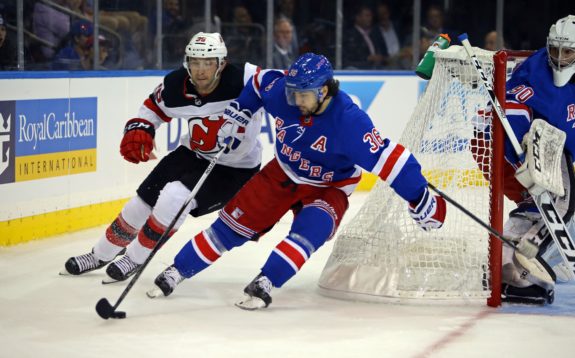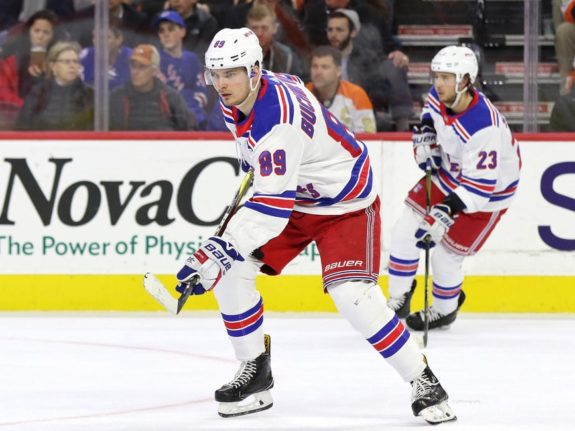This month seems to have come and gone, as February begins on Friday. This means we move closer to the NHL Trade Deadline, and the New York Rangers move closer to making tough, key decisions.
It’s been almost one year exactly since president Glen Sather and general manager Jeff Gorton released the letter to Rangers nation that signaled the official start of a rebuilding period. During 2017-18, the team traded away familiar faces and key players such as Rick Nash, J.T. Miller and former captain Ryan McDonagh. Ultimately, the fanbase was assured that this was in the Rangers’ best interest, so the team could get younger and compete for more Stanley Cups in years to come.

Now, with a mix of veterans and prospects, the Rangers are in the midst of an interesting season. They are rebuilding and aren’t doing well in the Eastern Conference standings, yet they have a .500 record. During this season, there have been some surprising highs, like the hot streak in November, and crushing lows such as the lack of defense. Some of the team’s youth has delivered, but others have struggled. Prior to the All-Star break, the team seemed to be tired from the grind of the NHL schedule.
The point is, this rebuild isn’t close to being done. So what should we expect in the coming month?
End of the Line for Zuccarello
Some are hoping to phase out every single one of the team’s veterans, but that ultimately isn’t possible. The longtime face of the franchise, Henrik Lundqvist, has a no-movement clause, and while it wouldn’t do justice to trade him anyway, the Swede has stated he will be with the team through the thick and thin of the rebuild. Marc Staal also has a no-movement clause, and Chris Kreider has a 10-team no-trade clause.
But the Rangers should focus on moves they can control, such as focusing efforts on two veterans who will be free agents at the end of this season: Mats Zuccarello and Kevin Hayes.

Of everyone on the team, Zuccarello is the odds-on favorite to be dealt, and both parties are facing that reality. Zuccarello is 31 and has been dealing with injuries recently, but he’s missed the 50-point mark once in his last five seasons (even then, he had 49 in 2014-15). He’s also been a valuable mentor to offensive rookies and a crowd favorite for years.
But when a team is at the point where their young players that need developing are clawing for ice time, moving a veteran becomes a necessity. Maybe the Rangers won’t receive the biggest haul for the product from Norway, who debuted in 2010-11, but there will be suitors.
Zibanejad & Kreider More Valuable Than Hayes
That leads us to Hayes, who is the third-most productive player on the Rangers’ offense statistically, behind Mika Zibanejad and Kreider. That trio has been the glue holding the Rangers together so far this season, but as long as the team’s playoff chances go in a southward direction, it makes more sense for the Blueshirts to offer him up, especially with a logjam at center. It would also give more ice time for players like Filip Chytil, Brett Howden (when he returns from injury) and Lias Andersson (should he get recalled from the AHL).
Zibanejad is younger than Hayes and the team’s scoring leader, plus the team committed to him with a deal that goes through 2021-22. Let’s not forget that Hayes almost missed being a Ranger this season, as he was pursuing a big deal during the offseason, and he will probably do the same after this campaign. In that case, is it worth trading Zibanejad and/or Kreider, especially if the team then loses out on Hayes in free agency? It is a rebuild, but it’s always safe to have a couple of veterans around.

Could the Rangers get a first-rounder for Hayes? Maybe, if it’s to a team that sees the center as the final piece for a huge playoff run. A top prospect might be too much to ask for in exchange for a rental, but maybe Hayes can be worth a couple of decent prospects.
There’s also the idea that the Rangers could trade Hayes (or Zucc) and re-acquire him during the offseason. Bizarre? Maybe, but it’s happened before, and the Rangers can look to a sports neighbor for a recent example: The New York Yankees signed Aroldis Chapman prior to 2016, only to trade him to the Chicago Cubs at their deadline in exchange for Gleyber Torres, and then the Yankees re-signed Chapman before the 2017 season.
Only Trade Youth if Necessary
Trading Ryan Spooner earlier this season wasn’t a big deal in terms of statistics, but it felt like the brass and first-year head coach David Quinn were sending a message: play hard and show your best or be benched or sent away, regardless if you’re a veteran or rookie. New York is focusing on its youth, of course, and shouldn’t make too many of these moves before Feb. 25; young players still need time to develop after all. But they could move a couple of their young guys in an effort to shake things up and give other talents a shot.
Look at what’s going on with Pavel Buchnevich. He was recently a healthy scratch for the fourth time this season. Something’s not clicking between him and Quinn it seems. Add to that, he hasn’t lived up to expectations in his first couple of NHL seasons and is a pending restricted free agent, Buchnevich may be a candidate to be moved if the Rangers decide to trade young talent. If not Buch, there’s a chance Vladislav Namestnikov or Jimmy Vesey could be moved, too. But again, any young player offered up should be a side piece that helps complete a deal the Rangers need, and it shouldn’t be done often.

There’s plenty for the Rangers to think about over the next few weeks. This doesn’t even consider Adam McQuaid, another pending free agent, or Kevin Shattenkirk, whose contract the Rangers might want to get rid of. Not everyone should be traded, but moves need to happen for the sake of the rebuild, no matter how much these players are loved. Your move, Mr. Gorton.